Top nature campsites
You’ll be amazed at the variety of animals to spot on some of our Club campsites
View our top nature campsitesWith a bit of planning and a willingness to travel, it’s possible to get up close and personal with ‘the clowns of the sea’. David Chapman highlights five puffin colonies
 There’s a reason it’s called ‘Fair Isle’
There’s a reason it’s called ‘Fair Isle’
I sometimes think we downplay the nature found on our small islands compared to that of bigger, more wooded nations. For starters, our coastline boasts larger and more easily accessible seabird colonies than many other countries. And represented among those colonies is the best-loved seabird of them all: the puffin.
June is the best time to visit a puffin colony, as this is when the charismatic birds are busy carrying sand eels back to their nests to feed their young. It’s difficult to be exact, but generally the second week of June is when puffins start feeding their young in the south, and mid-to-late June is the time to go spotting in the north. Most puffins leave their colonies from mid-to-late July.
Over these pages I present a selection of locations based on my own experiences of watching puffins around the UK – so apologies if I have not chosen your favourite. One factor that is particularly important to me is the proximity of the birds and the intimacy of the experience.
Potential base: Berwick Seaview Club Campsite
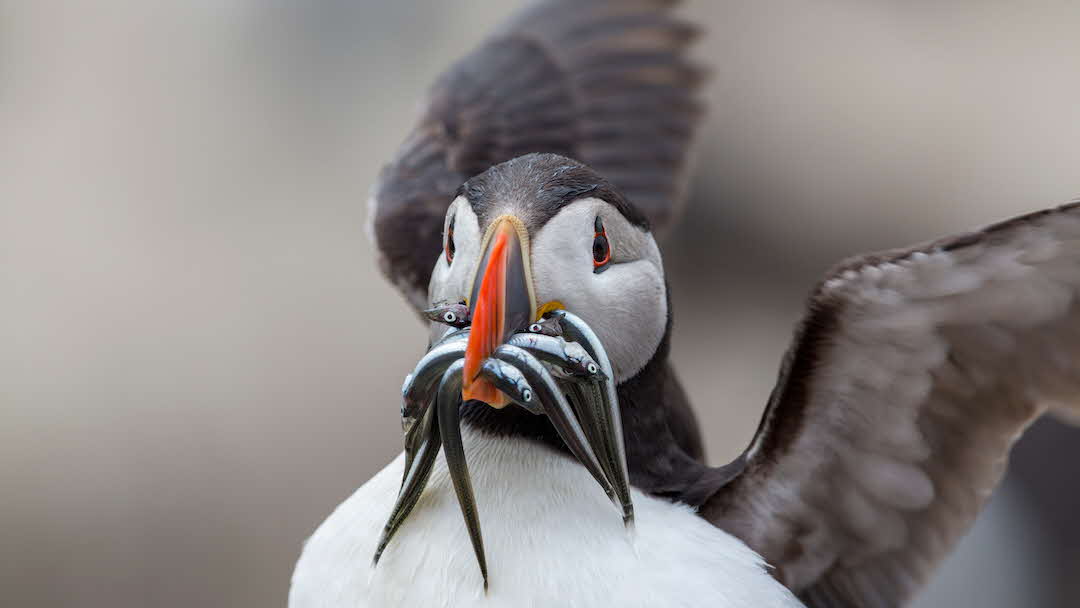 A puffin with sand eels
A puffin with sand eels
The Farne Islands are easily accessible by boat from Seahouses in Northumberland. Note that time on the islands is limited and the tours can be very popular. It’s possible to land on both Staple Island and Inner Farne – I have found Staple Island to be slightly better for puffins, but both can offer great opportunities.
Be prepared to be bombarded by birds, quite literally! Shags, guillemots, razorbills, eiders, kittiwakes and sandwich terns will all do their best to distract you from the puffins, while arctic terns can attempt to stab you on the head – so take a hat!
Visit the Farnes and you will see why the British Isles are such a draw for wildlife photographers from around the world.
There is nowhere else quite like it. (Please note that, as we went to press, landing access to the Farne Islands was restricted due to fears over avian flu.)
Potential base: Freshwater East or St David’s Lleithyr Meadow Club Campsites
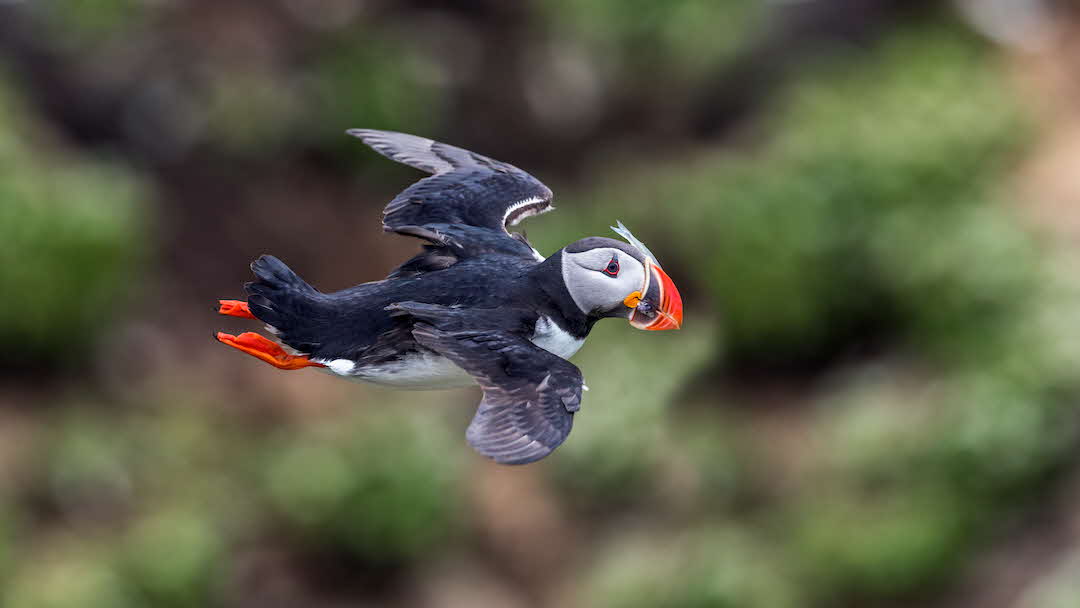 Heading back to its young
Heading back to its young
Skomer Island sits off the coast of Pembrokeshire, Wales. It is possible to take a day trip to the island, but my preference is to stay overnight: far fewer people are about in the evenings and early mornings, and the puffins tend to be more active around their nests in the twilight hours. This not only allows for a more intimate experience, but means that the light can be much better for photography. There is another, non-puffin-related reason for staying overnight: to experience the return of the Manx shearwaters to their nests in the dead of night.
Skomer has a decent number of puffins and many of their nests are adjacent to the perimeter path at The Wick on the south of the island, so there is no problem getting close to them – in fact, they often come too close!
Member saving available: you can save 10% on a boat trip to see the Skomer Island puffins with Thousand Islands Expeditions – see camc.com/greatsavingsguide for details, terms and conditions.
Potential base: Bunree Club Campsite, North Ledaig AS
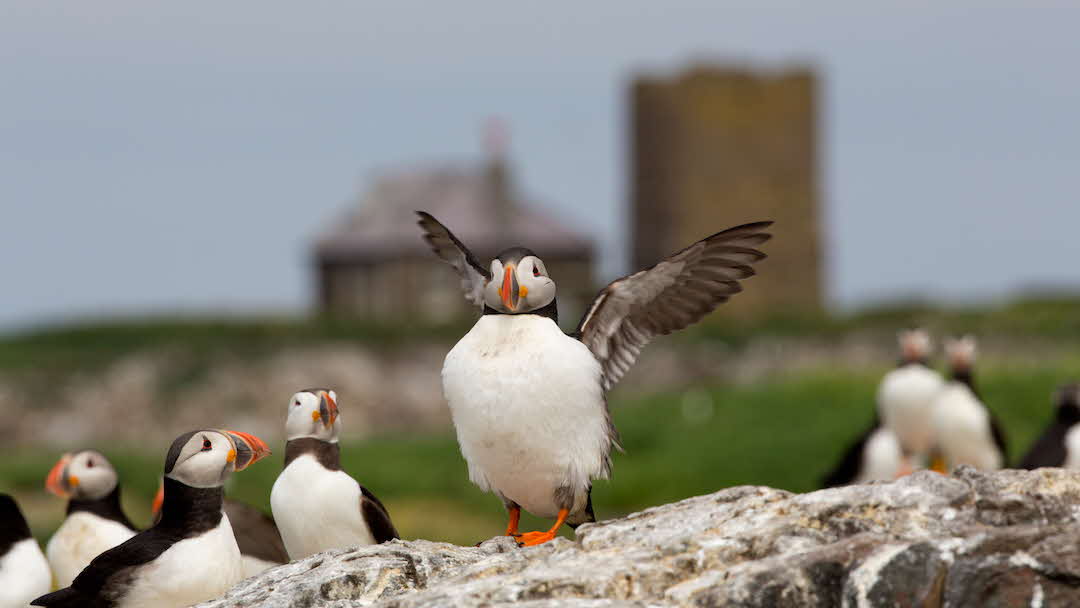 Wing-stretching on Staple Island
Wing-stretching on Staple Island
Lunga is the largest of the Treshnish Isles, part of the Inner Hebrides off the west coast of Scotland and accessible by boat from the Isle of Mull. It might seem remote to some, but the Isle of Mull is a great place to visit if you are interested in wildlife, and Lunga is just a day trip away (overnight stays are not permitted). And, because of its remoteness compared to Skomer and The Farnes, it receives fewer visitors.
Access from the landing bay is difficult, with a boulder beach to navigate before climbing the small slope onto the island. Puffins sit at the top waiting to welcome you ashore. I would describe the Lunga puffins as inquisitive; lie down beside the path and they will pop their heads out of their burrows to have a look, eventually plucking up the courage to stand on the ridge just a few metres away.
Such is the richness of the birdlife on Lunga that you shouldn’t focus solely on the puffins. Take time to explore some of the rest of the island, particularly in the direction of the sea stack (Dun Cruit) on the west coast, where you will be able to observe many other seabirds.
Potential base: Dunnet Bay Club Campsite
Stanger Head offers the possibility of having a puffin colony all to yourself. Situated on Westray, one of the Orkney Islands, to visit you will need to travel to the north of Scotland (see orkney.com for options), then take a couple of ferries onwards. No mean feat, but it keeps visitor numbers low.
Stanger Head is easily the best location I know of in the Orkney Islands for puffins. Timing is essential, however. Puffin colonies can be relatively quiet during the daytime, particularly in May and early June, before the adults have young to feed. Indeed, at Stanger Head, it wasn’t until the evening that the puffins returned in any numbers, but fortunately the days are long in June and on my last visit I was photographing puffins at 11pm!
Potential base: Dunnet Bay Club Campsite
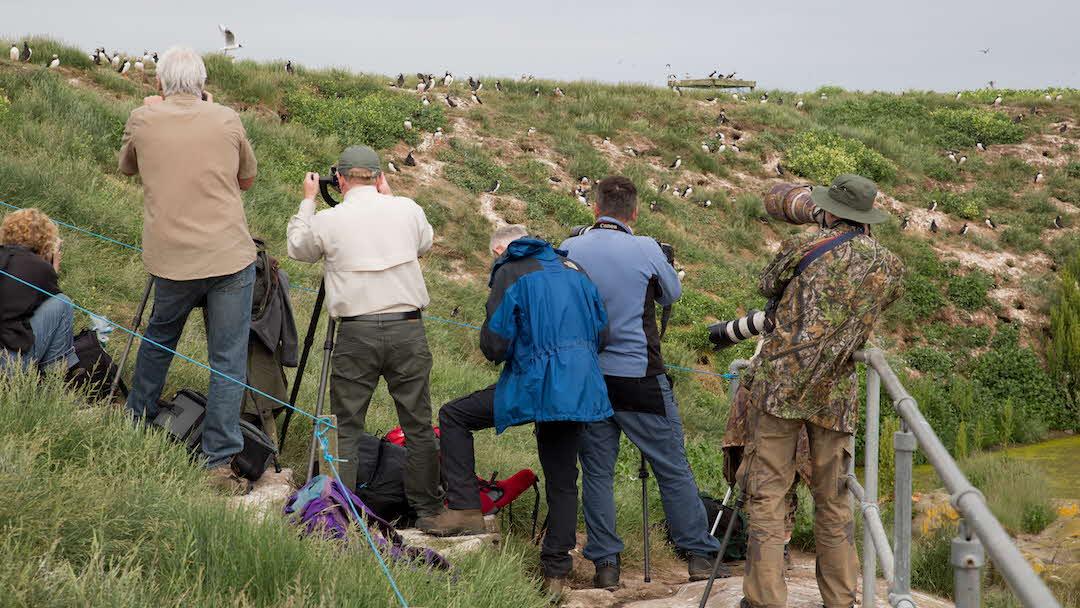 Photographers are drawn to Staple Island, Farne
Photographers are drawn to Staple Island, Farne
It’s a bit of a cop-out to treat Shetland as one location, but there are so many puffin possibilities on our most northerly archipelago that to focus on just one wouldn’t do it justice. I recommend beginning at Sumburgh Head at the southern tip of Shetland’s Mainland. The puffins get quite close to the path here, and staff at the visitor centre will advise about the best places to visit.
Elsewhere on Shetland I recommend Hermaness, the most northerly spot on the island of Unst. Hermaness is a must-see for wildlife lovers visiting Shetland as it is home to many breeding seabirds including great skuas and plenty of waders. However, in my experience, puffin numbers have declined, making it difficult to see them close-up. The tops of the cliffs here are very dangerous, so care must be taken.
Fair Isle is a wonderful spot and great for puffins. Although it is very remote, overnight stays are possible, which makes a visit more manageable and experiences with puffins very intimate and atmospheric. Finally, the Isle of Noss is another notable spot for seabirds including puffins.
Every month I will show you a photo of something from the natural world. It might be a close-up, or a subject which is difficult to identify. All you have to do is figure out what it is! Here is this month’s photo; no clues or prizes – it’s just for fun. (I will give you the answer next month, but if you can’t wait, see the digital magazine.)
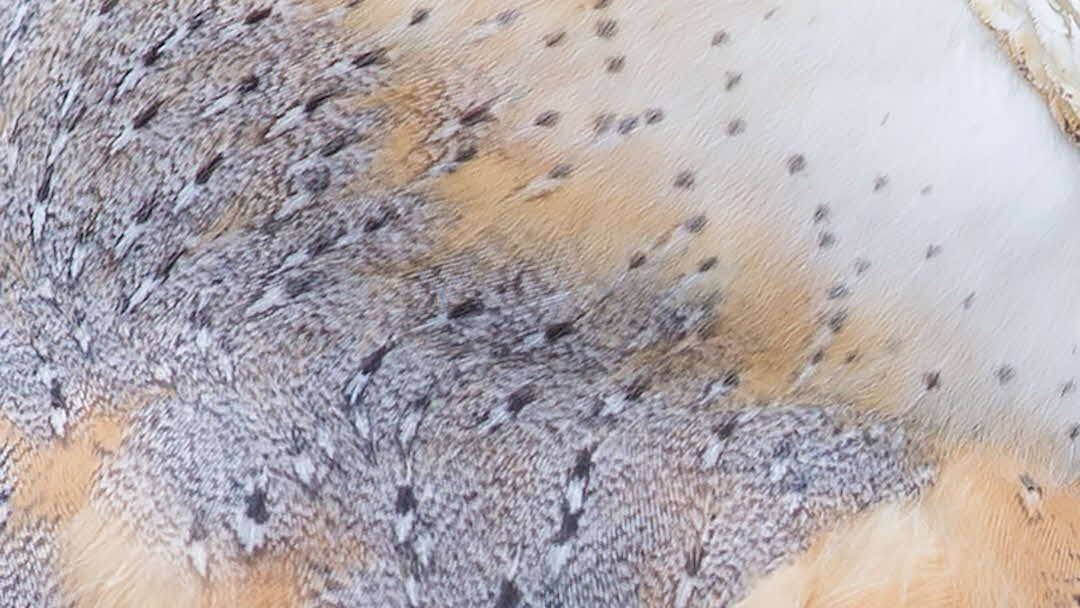
The subject of May’s mystery photo was: an otter.